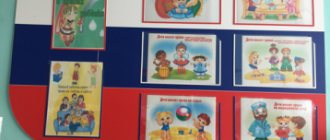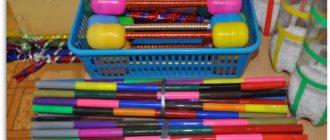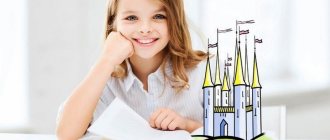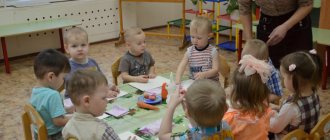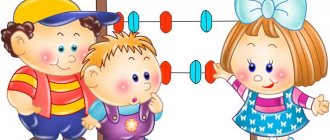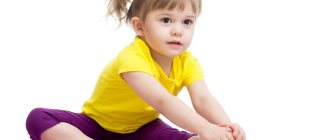Author - Anna Makarova, educational psychologist
When the school year in kindergarten comes to an end, it's time to take stock. Children have their own results, teachers have their own, but the main element that completes the educational process is the final classes in kindergarten. They allow you to summarize the acquired knowledge, skills and abilities, and put a logical point in the learning process. In addition, final classes in kindergarten also involve mandatory analysis and systematization of knowledge.
Classes of this kind are held regularly at the end of each educational stage. Thanks to the final classes, the teacher can have an idea of the degree of knowledge acquisition, plan, if necessary, additional training sessions, monitor how suitable the chosen educational program is for the goals and objectives, as well as whether its capabilities correspond to the age and characteristics of the children, and , if necessary, make changes to it.
Final classes in kindergarten: see off kindergarten!
Final classes in kindergarten are of particular importance in the preparatory group, due to the fact that in this situation they sum up not only the year, but also the entire education within the preschool educational institution. In many institutions, final final classes in kindergarten are conducted in the form of open lessons, and sometimes even in the format of extended matinees, with invited parents. The difference between such matinees and ordinary ones is that they contain elements of generalization and systematization of the knowledge acquired by children in preschool educational institutions.
To think over and conduct a final lesson that would combine a celebration on the occasion of the end of kindergarten and a real systematization of the acquired knowledge, skills, abilities - this is pedagogical aerobatics. However, it is precisely these open morning lessons that are most effective, as they combine business with pleasure, leaving behind a lot of pleasant emotions for both children and parents. And colorful photographs from such lessons are a reason not only to replenish albums with memories, but also to compile impressive teaching reports.
The combination of a final lesson and a gala event may not be very big. For each of the subjects studied in preschool educational institutions, separate final classes are held in kindergarten, at their usual time. Parents can be invited based on the capabilities of the classrooms - it is not worth dragging many people into a cramped classroom, but at the same time, you should not hastily organize an open lesson in the assembly hall without properly equipping it for the needs of the children and the pedagogical process.
The main difference between a ceremonial final lesson and a regular one can be a special element, for example, a theatrical performance, music and singing, or an interactive game. Of course, all final classes in kindergarten, conducted in the preparatory group, should be devoted to one main topic - farewell to kindergarten and the transition to school life. The maximum use of visual teaching materials and modern technical means is encouraged. You can show children an educational film or cartoon related to the subject and preparation for school.
Interesting ideas for the general leitmotif of the assignment: a journey from kindergarten to home, an impromptu excursion to school, stories about school in the form of problems and exercises, and more. For each of the subjects studied, you can find its own connection with the transition of children to a new stage of learning.
Methodological recommendations “Methodology for conducting classes in preschool educational institutions” (for educators)
Methodology for conducting classes in preschool educational institutions
1. Classes as a form of training
The leading form of organizing the education of preschool students is the lesson.
The use of classes as the main form of teaching children was justified by Ya.A. Comenius.
Jan Amos Comenius in his pedagogical work “The Great Didactics” really described the class-lesson system as “the universal art of teaching everyone everything”, developed rules for organizing a school (concepts - school year, quarter, vacation), a clear distribution and content of all types of work, substantiated didactic principles of teaching children in the classroom. In addition, he was one of the first to put forward the idea that the beginning of systematic education and training lies in preschool age, developed the content of teaching preschool children and outlined them in the pedagogical work “Mother’s School”.
K.D. Ushinsky psychologically substantiated and developed the didactic principles of teaching children in the classroom, emphasizing that already at preschool age it is necessary to separate serious learning from play “you cannot teach children by playing, learning is work.” Therefore, the tasks of preschool education, according to K.D. Ushinsky, is the development of mental strength (development of active attention and conscious memory) and the gift of speech of children, preparation for school. However, at the same time, the scientist put forward the thesis of the duality of teaching and raising preschool children. Thus, the problem of the existence of differences between children's learning in kindergarten classes and in primary school classes was raised.
A.P. Usova developed the basics of teaching preschool children in kindergarten and family, revealed the essence of education in kindergarten; substantiated the position about two levels of knowledge that children can master.
To the first level she included the elementary knowledge that children acquire in the process of games, life activities, observation and communication with people around them; to the second, more complex level, she included knowledge and skills, the acquisition of which is possible only in the process of targeted learning. At the same time, A.P. Usova identified three levels of educational activity depending on the cognitive motives of children, the ability to listen and follow the instructions of an adult, evaluate what has been done, and consciously achieve set goals. At the same time, she emphasized that children do not reach the first level immediately, but only towards the end of preschool childhood, under the influence of targeted and systematic training.
Systematic training in the classroom is an important means of educational work with preschool children.
Over the course of several decades of the twentieth century. all leading researchers and practitioners of preschool education following A.P. Usova paid great attention to classes as the leading form of frontal education for children.
Modern preschool pedagogy also attaches great importance to classes: undoubtedly, they have a positive impact on children, contribute to their intensive intellectual and personal development, and systematically prepare them for school.
Currently, the improvement of classes continues in various aspects: the content of training is expanding and becoming more complex, a search is being made for forms of integration of different types of activities, ways to introduce games into the learning process, and a search for new (non-traditional) forms of organizing children. Increasingly, one can observe a transition from frontal classes with the entire group of children to classes with subgroups and small groups. This trend ensures the quality of education: an individual approach to children, taking into account the characteristics of their progress in acquiring knowledge and practical skills.
Another important trend is visible - the construction of lesson systems in each area that preschoolers are introduced to. A chain of gradually more complex activities, organically connected with the activities of everyday life, is the optimal way to ensure the necessary intellectual and personal development of preschool children.
The form of organization of training is a joint activity of the teacher and students, which is carried out in a certain order and established mode.
Traditionally, the following forms of training organization are distinguished:
individual, group, frontal
You can use these forms of learning organization both in the classroom and in everyday life. In a preschool educational institution, special time can be allocated during the implementation of regime moments, and individual work with children can be organized. The content of learning in this case is the following types of activities: subject-based games, work, sports, productive, communication, role-playing and other games that can be a source and means of learning.
2. Characteristics and structure of classes
Teaching in the classroom, regardless of the form of its organization, differs primarily in its programming. The teacher outlines the program content that should be implemented during the lesson.
Classes have a certain structure, which is largely dictated by the content of training and the specifics of the children’s activities. Regardless of these factors, in any lesson there are three main parts, inextricably linked by general content and methodology, namely:
the beginning, the course of the lesson (process) and the end.
Start of class
involves the direct organization of children: it is necessary to switch their attention to the upcoming activity, arouse interest in it, create an appropriate emotional mood, and reveal the educational task. Based on the explanation and demonstration of methods of action, the child forms an elementary plan: how he will need to act himself, in what sequence to complete the task, what results to strive for.
Progress (process) of the lesson
- this is an independent mental or practical activity of children, consisting in the acquisition of knowledge and skills that are determined by the educational task. At this stage of the lesson, techniques and teaching are individualized in accordance with the level of development, pace of perception, and thinking characteristics of each child. Appeals to all children are necessary only if many have errors in completing a learning task as a result of an unclear explanation from the teacher.
Minimal assistance is provided to those who quickly and easily remember, are attentive, know how to analyze, and compare their actions and results with the instructions of the teacher. In case of difficulty, advice, reminders, and a guiding question are enough for such a child. The teacher gives each student the opportunity to think and try to independently find a way out of a difficult situation.
The teacher must strive to ensure that each child achieves a result that indicates his progress, showing what he has learned.
End of class
is devoted to summing up and assessing the results of children's educational activities. The quality of the result obtained depends on the age and individual characteristics of the children, and on the complexity of the learning task.
Depending on the section of training and the goals of the lesson, the methodology for conducting each part of the lesson may be different. Private methods provide more specific recommendations for conducting each part of the lesson. After the lesson, the teacher analyzes its effectiveness, the children’s mastery of program tasks, reflects on the activity and outlines the prospects for the activity.
In the structure of classes in kindergarten, there is no assessment of the acquisition of knowledge, skills and abilities. This verification is carried out in the process of observing children’s activities in the classroom, analyzing the products of children’s activities, as well as in everyday life and during a special study of children’s achievements using various scientific methods.
3. Classification of activities in preschool educational institutions
Currently, the following classification of activities with preschool children is widely used.
Classification of occupations in preschool educational institutions (according to S.A. Kozlova)
| Basis of classification | Name |
| 1.Didactic task | 1. Classes for mastering new knowledge and skills; 2. Classes to consolidate previously acquired knowledge and skills; 3. Classes in the creative application of knowledge and skills; 4. Complex classes, where several tasks are solved simultaneously. |
| 2. Content of knowledge (training section) | 1. Classical lessons by sections of study; 2. Integrated (including content from several sections of training). |
Currently, complex classes predominate, in which several didactic tasks are simultaneously solved (systematization of knowledge, skills and development of creative abilities, etc.)
The content of the classes can be integrated, i.e. combine knowledge from several areas and differentiate it.
Integrated unification is not arbitrary or mechanical. It is necessary to provide for the integration of knowledge in such a way that they complement and enrich each other when solving didactic problems.
Integration makes significant adjustments in the ratio of studying several sections of educational activities, since the logical structure of passing sections of the program changes, and thus the time allotted for studying individual issues is reduced due to the removal of repetitions in one or another subject, which makes it possible to more actively use game forms of work on classes.
Integration in the content of classes performs 2 main functions: substantive and formal.
Thus, integrated classes are more consistent with the concept of person-centered learning and contribute to the development of the child’s personality, while single-type classes are focused on the development of activity.
Classes are conducted in the following sections of training:
— familiarization with the surrounding life and development of children’s speech;
— development of elementary mathematical concepts;
— visual activity and design;
- Physical Culture;
- musical education.
The content of a specific lesson is developed based on the requirements of the “Education Program” for this section, taking into account the level of development of children’s educational and cognitive activities and mastery of the previous program, as well as the general tasks of the upbringing and development of children of different age groups.
The program of each lesson includes:
- a certain amount of knowledge about the properties and qualities of objects, their transformation, connections, methods of action, etc., their primary assimilation, expansion, consolidation, generalization and systematization;
— the volume of practical skills and abilities in teaching productive activities;
- the volume of skills and abilities needed for educational and cognitive activity, their primary formation or improvement, exercise in application;
- formation of children’s attitude to phenomena and events, to knowledge that is communicated and acquired in this lesson, nurturing attitudes towards their own activities, establishing relationships of interaction with peers.
The volume of educational content in each lesson is small, it is determined taking into account the memory and attention span of children of different age groups, and the capabilities of their mental performance.
A special type of activity is excursions. Educational and educational tasks during excursions are solved in unity. In this case, it is necessary to remember the local history and seasonal principles, as well as the principles of repetition, gradualism, and clarity.
The triune task of the lesson
Educational: increase the level of child development
Educational: to form the moral qualities of the individual, views and beliefs.
Developmental: when teaching, develop students’ cognitive interest, creativity, will, emotions, cognitive abilities - speech, memory, attention, imagination, perception.
4. Non-traditional forms of classes
Currently, in the practice of preschool institutions, non-traditional forms of organizing education are effectively used: classes in subgroups, which are formed taking into account the age characteristics of children. They are combined with circle work: manual labor, visual arts. Classes are enriched with games and fairy tales. The child, carried away by the concept of the game, does not notice the hidden educational task. These activities help free up the child’s time, which he can use as he wishes: relax or do something that is interesting or emotionally significant to him.
The project method is used today not only in the process of conducting classes on environmental education of children in preschool educational institutions. Its use characterizes the search by educators for new forms of organizing the learning process and conducting classes with children in preschool educational institutions.
The project method is widely used today in working with pupils of different age groups, groups of short-term stays of children in preschool educational institutions. At the same time, according to N.A. Korotkova and a number of other researchers, classes in this case, in contrast to the traditional approach, can be carried out in the form of joint partnership activities between an adult and children, where the principle of voluntary inclusion in the activity is observed. This is especially true for productive activities: design or modeling, drawing, appliqué.
Various forms of “passionate activities”, rich in games and independent creative activities, are widely used. All this, of course, makes the activity more interesting, attractive, and more effective.
Such forms as lesson-conversation and lesson-observation have become widely used in the practice of organizing and conducting classes. These forms are used in senior groups of preschool educational institutions.
Fairytale therapy classes are popular. Fairytale therapy sessions with children are a special, safe form of interaction with a child, most appropriate to the characteristics of childhood. This is an opportunity to form moral values, correct undesirable behavior, and a way to develop the necessary competencies that contribute to the constructive socialization of the child.
The use of didactic fairytale therapy trainings in the format of preschool education allows children to easily and quickly acquire the necessary knowledge.
5. Features of organizing and conducting classes in different age groups
Achieving positive results depends on the correct organization of the educational process. When attending classes, first of all, you should pay attention to compliance with hygienic conditions: the room must be ventilated; in general normal lighting, the light should fall from the left side; equipment, tools and materials and their placement must meet pedagogical, hygienic and aesthetic requirements.
The duration of the lesson must comply with established standards, and the time must be used fully. Of great importance is the beginning of the lesson, organizing children's attention, setting an educational or creative task for children, and explaining how to complete it.
It is important that the teacher, while explaining and showing methods of action, activates the children, encourages them to comprehend and remember what he is talking about. Children should be given the opportunity to repeat and pronounce certain provisions (for example, how to solve a problem, make a toy). The explanation should not take more than 3-5 minutes.
During the lesson, the teacher involves all children in active participation in the work, taking into account their individual characteristics, develops children's learning skills, and develops the ability to evaluate and control their actions. The educational situation is used to develop in children a friendly attitude towards friends, endurance, and determination.
During the lesson, the teacher imparts knowledge to the children in a strict logical sequence. But any knowledge (especially new knowledge) must be based on the child’s subjective experience, his interests, inclinations, aspirations, individually significant values that determine the uniqueness of each child’s perception and awareness of the world around him.
In the process of communication in the classroom, not only a one-sided influence of the teacher on the child occurs, but also a reverse process.
The child should have the opportunity to make maximum use of his own existing experience, which is personally significant for him, and not just unconditionally accept (“assimilate”) everything that the teacher tells him.
In this sense, the teacher and the child act as equal partners, bearers of heterogeneous, but equally necessary experience. The main idea of a personality-oriented lesson is to reveal the content of the child’s individual experience, coordinate it with what is being asked, and thereby achieve personal assimilation of this new content.
The teacher must think through not only what material he will report, but also what possible connections this material may have with the children’s personal experience.
When organizing a lesson, the professional position of the teacher is to obviously respect any statement of the child on the content of the topic under discussion.
We need to think about how to discuss children’s “versions” not in a rigidly evaluative situation (right - wrong), but in an equal dialogue. Only in this case will children strive to be “heard” by adults.
One of the forms of increasing the performance of children, preventing fatigue associated with great concentration, prolonged attention, as well as monotonous body position while sitting at the table, is a physical training minute. Physical education sessions have a beneficial effect on increasing the activity of children and help prevent postural disorders. In all kindergartens in the city, physical education sessions are organized systematically. Usually these are short breaks (2-3 minutes) to carry out 2-3 physical exercises in mathematics, native language, and art classes. In the second junior and middle groups, physical education sessions are held in the form of a game. The timing and selection of exercises are determined by the nature and content of the lesson. So, for example, in drawing and sculpting classes, physical education includes active flexion, extension of the arms, pinch and spread of the fingers, and free shaking of the hands. In classes on speech development and mathematics, exercises are used for the back muscles - stretching, straightening with deep breathing through the nose. Children tend to remain in their seats during exercise. In order to enhance the emotional impact of physical education minutes, educators can use short poetic texts.
In each age group, classes have their own characteristics, both in terms of time and organization.
With kids:
Up to 3 years of age, it is recommended to conduct 10 lessons per week lasting 8-10 minutes.
4th year of life – 10 lessons lasting no more than 15 minutes.
5th year of life – 10 lessons lasting no more than 20 minutes.
6th year of life – 13 lessons lasting no more than 25 minutes.
7th year of life – 14 lessons lasting no more than 30 minutes.
Additional education classes, if provided for in the preschool educational plans, are conducted in agreement with the parent committee. In the second junior group - 1 lesson, in the middle group - 2 lessons, in the senior group - 2 lessons, in the preparatory group - 3 lessons per week.
In accordance with the approximate daily routines and time of year, group classes are recommended to be held from September 1 to May 31. The educator is given the right to vary the place of classes in the pedagogical process, to integrate the content of various types of classes depending on the goals and objectives of training and education, their place in the educational process; reduce the number of regulated classes, replacing them with other forms of training.
In early preschool age, children have games and activities. In the first early age group, children are taught individually. Due to the fact that in the first year of a child’s life, skills are formed slowly and their formation requires frequent exercises, games and activities are carried out not only daily, but several times during the day.
In the second early age group, 2 classes are held with children. The number of children participating in classes depends not only on their age, but also on the nature of the lesson and its content.
All new types of classes, until children master primary skills and master the necessary rules of behavior, are carried out either individually or with a subgroup of no more than 3 people.
A subgroup of 3-6 people (half the age group) conducts classes on teaching subject activities, design, physical education, as well as most classes on speech development.
With a group of 6-12 people, you can conduct classes with a free form of organization, as well as musical ones and those where the leading activity is visual perception.
When combining children into a subgroup, it should be taken into account that their level of development should be approximately the same.
Lesson duration – 10 minutes for children from 1 year to 6 months. and 10-12 minutes for seniors. However, these figures may vary depending on the content of the learning activity. New types of activities, as well as those that require more concentration from children, may be shorter.
The form of organizing children for classes can be different: kids sit at a table, on chairs arranged in a semicircle, or move freely around the group room.
The effectiveness of a lesson largely depends on how emotional it is.
An important didactic principle on which the methodology for teaching children of the 2nd year of life is based is the use of visualization in combination with words.
Teaching young children should be visual and effective.
In groups of older children, when cognitive interests are already well developed, a message about the topic or main goal of the lesson is sufficient. Older children are involved in organizing the necessary environment, which also contributes to interest in the activity. However, the content and nature of setting educational objectives are of primary importance.
Children gradually become accustomed to certain rules of conduct in class. The teacher constantly reminds the children about them both when organizing the lesson and at the beginning of it.
At the end of the lesson with older children, a general summary of cognitive activity is formulated. At the same time, the teacher strives to ensure that the final judgment is the fruit of the efforts of the children themselves, to encourage them to emotionally evaluate the lesson.
The end of the lesson in younger groups is aimed at enhancing positive emotions associated with both the content of the lesson and the children’s activities. Only gradually in the middle group is some differentiation introduced in assessing the activities of individual children. The final judgment and assessment is expressed by the teacher, from time to time involving the children in it.
The main form of training: developmental classes using methods, didactic games, and gaming techniques.
The main forms of organization of children of older groups in the classroom are frontal and subgroup.
6. Preparing the teacher for the lesson
When organizing a lesson with preschoolers, it is necessary, first of all, to determine its main goal. And it lies in whether this activity will be of a developmental nature or pursue a purely educational goal. In the educational lesson, children accumulate the necessary personal experience: knowledge, abilities, skills and habits of cognitive activity, and in the developmental lesson, using the acquired experience, they independently obtain knowledge. Therefore, both developmental and educational activities should be used in the educational process of a preschool institution. It must be remembered that in order for a child to be successful in his own research activities, he needs certain knowledge and skills.
Children begin to acquire independent research skills during training sessions. For this purpose, they introduce elements of a problematic presentation of educational material, heuristic conversation, organize a collective or individual independent search, and experimental activities. Often in practice, such activities in a preschool institution are called developmental. Unfortunately this is not true. Such classes are only an approach to real developmental classes, the essence of which is the development of the categorical structure of consciousness and the ability for independent search activity on the child’s own initiative, the ability to further define and redefine tasks coming from an adult. Educational and developmental classes are built according to completely different schemes, and educators should know this well. Below we present models for constructing training (often called traditional) and developmental classes.
Model for constructing a training session
Such a model for constructing a teaching lesson leaves the teacher quite a lot of scope for using various methods and teaching technologies, since the psychological chain of activity is not destroyed: “motivation - perception - comprehension” - and, as a rule, the educational goal can be achieved in the vast majority of cases.
Developmental lesson model
Usually, when preparing for a lesson, a teacher selects didactic material that allows him to use tasks of varying degrees of difficulty.
The selection of didactic material for a student-oriented lesson also requires the teacher to know the individual preferences of each child in working with the material. He should have a set of didactic cards that allow the child to work with the same content provided for by the program requirements, but convey it in different ways: in words, symbols, drawings, object images, etc.
Of course, the child must be given the opportunity to show individual selectivity in working with the material. Classification of didactic material, selection and use of it during the lesson require special training of the teacher, and above all knowledge of the psychophysiological characteristics of children, the ability to identify and use them productively in the process of assimilation.
The lesson script and its “directing” are no less important. Communication in the classroom should be structured in such a way that the child can choose the task that interests him most in terms of content, type and form - and thereby express himself most actively. To do this, the teacher should classify all information methods of work in the classroom (instructional, content-based, instructive) as frontal, and all forms of independent or pair work as individual. This requires taking into account not only the cognitive, but also the emotional-volitional, motivational-need characteristics of children and the possibilities for their manifestation during the lesson. Therefore, when preparing for a lesson, it is necessary to design in advance all possible types of communication subordinated to educational goals, all forms of cooperation between learning partners.
Development of a flexible plan includes:
— determination of the general goal and its specification depending on the different stages of the lesson;
- selection and organization of didactic material that allows us to identify the individual selectivity of children to the content, type and form of knowledge;
— planning different forms of work organization (the ratio of frontal, individual, independent work);
— selection of criteria for assessing work productivity, taking into account the nature of the tasks (word-for-word retelling, presentation in your own words, performing creative tasks);
— planning the nature of communication and interpersonal interactions during the lesson:
a) the use of different forms of communication (monologue, dialogue) taking into account the goals of the lesson;
b) designing the nature of children’s interactions in the classroom, taking into account their personal characteristics and requirements for intergroup interaction;
c) using the content of the subjective experience of all participants in the lesson in the dialogue “child - teacher” and “child - children”.
Planning the effectiveness of the lesson includes:
1) generalization of acquired knowledge and skills, assessment of their mastery;
2) analysis of the results of group and individual work;
3) attention to the process of completing tasks, and not just to the result.
The lesson will be held correctly, fully, with benefit for the children, if before conducting it the teacher correctly draws up a plan for the event, prepares and organizes everything.
The systematic teaching of children is one of the most important principles for solving the complex of educational work in preschool institutions. Only with proper planning of the learning process can a program for the comprehensive development of a child’s personality be successfully implemented.
An important principle of organizing the learning process is systematicity. At the stage of early childhood, the acquisition of knowledge, as well as the formation of skills, must take place systematically.
Due to the fact that a large interval between classes is undesirable, there is a need to consolidate children's acquired knowledge and skills in independent activities and partly in classes aimed at children mastering actions with objects in other classes.
The issue of repetition of classes requires special attention: the period of early childhood is characterized by an unusually rapid pace of development, and each age microperiod must be approached differentially. A repetition lesson should not be completely identical to the main lesson. Simple repetition of the same tasks can lead to mechanical, situational memorization, rather than to the progressive development of mental activity in the classroom.
Variability in completing tasks, recommended instead of mechanical, situational learning, ensures the strength and depth of knowledge and skills.
Special tact should be shown when planning individual work with children. It is important to remember that this work does not turn into additional activities. The teacher should only interest and make the child want to play with the didactic material. You cannot take your child away from things that are interesting to him for the sake of additional activities.
The analysis of the lessons conducted requires special attention. The criterion can be an assessment of the level of independence in their implementation. Some children complete tasks quickly, without mistakes. The majority of children complete individual assignments with occasional assistance from the teacher. They can make mistakes and correct them either on their own, or when the teacher asks “What is wrong with you?”, or with the direct participation of an adult. At the same time, children show great activity, making repeated comparisons and comparisons, which allows them to master tasks qualitatively. Some children require constant assistance in the form of element-by-element dictation. For preschoolers who are at this level of task completion, the lesson material turns out to be too high. You need to know the reason for their lag (the children could be sick or simply not attend the child care facility enough). It is important for the teacher to track the children’s progress from lesson to lesson.
So, a number of characteristics are characteristic of a lesson as a form of learning organization:
1. During the classes, children master skills in one or another section of training.
2. Classes are held with all children of a given age group, with a constant composition of children.
3. Classes are organized and conducted under the guidance of an adult, who determines the objectives and content of the lesson, selects methods and techniques, organizes and directs the cognitive activity of children in mastering knowledge, skills and abilities.
Classes occupy a special place in the system of educational work of the kindergarten. Classes are allocated a strictly fixed time in the children’s daily routine.
As a rule, these are the morning hours, when children's mental and physical performance is highest.
When combining activities, the degree of difficulty and the nature of the children’s activities in each of them are taken into account.
Final lessons in kindergarten: structure and analysis
In its structure, the final lesson in kindergarten should, in principle, not differ from a regular lesson. It must necessarily contain things familiar to the teacher: goals, program content, description of the course of the lesson, methods and materials.
If you are a teacher or trainee, then one of your tasks may be an analysis of the final lesson. All teachers must conduct pedagogical analysis as part of mutual visits and exchange of experience.
The analysis of the final lesson should include the following points:
- characteristics of children,
- degree of difficulty of the lesson,
- characteristics of software tasks,
- feedback on the type of activity and its correspondence to the age of the children, as well as the tasks set.
The analysis should also contain information about the degree of disclosure of the methods and techniques used, highlighting the pros and cons of the lesson.
Practical advice for educators on conducting classes on the Federal State Educational Standard before
Kristina Vershinina
Practical advice for educators on conducting classes on the Federal State Educational Standard before
1. Think over the organization of children in the classroom (alternating different types of children’s activities: sitting, standing, on the carpet, in groups, in pairs, etc.)
2. High-quality preparation of visual materials for the lesson (accessibility to every child, modernity, quality and size of illustrations, multimedia presentations can be shown)
3. Compliance with the structure of the lesson :
— Introductory part (creating motivation and “don’t forget”
about her throughout
the lesson . For example, if Dunno came, then throughout the lesson he “participates”
in activities with children, at the end
of the lesson you can sum up the results on behalf of the character)
-Also in the first part of the lesson it is necessary to create a problem situation (or a problem-search situation)
for children, the solution of which they will find throughout the event. This technique allows preschoolers not to lose interest, develops mental activity, and teaches children to interact in a team or in pairs.
- During the main part, the teacher can use various management techniques: visual, practical and verbal , allowing him to solve the program tasks of the lesson and the problem-search situations posed.
— After each type of children’s activity, the teacher needs to conduct an analysis of the children’s activities (either on his own behalf, or on behalf of the character or with the help of other children)
is a requirement
In cases where something is not working out for children, the teacher can use a technique such as pedagogical support. For example, the teacher says : “I really liked how Seryozha, Marina and Lena made the traffic light, but Maxim and Oleg’s parts came off, but I think that next time they will definitely try and do everything well.”
Throughout the entire lesson (especially in older preschool age groups)
The teacher must monitor and encourage children to engage in speech activity with the help of questions.
Therefore, questions for children must be thought out in advance; they must be exploratory or problematic in nature; strive to ensure that children answer with a “complete answer”
.
You also need to control your own speech and construct speech phrases in the third person. For example, move away from the expression: “I want to invite you on a trip.”
- this is not correct, because the teacher seems to be
“imposing”
the upcoming activity. It would be more correct to address the children in this way:
“Let’s go on a trip.”
-Also, in accordance with new educational standards, the teacher can use pedagogical technologies: problem-based learning, research activities, project activities, health-saving technologies and more. (Depending on their type of children's activity and on the assigned tasks in the lesson ) For example, in a lesson on cognitive development in the second junior group “Visiting the Cockerel”,
the teacher can conduct articulatory gymnastics to develop breathing, etc. The
final part of the lesson should be organized like this in such a way that the solution to the problem and search situation can be traced (so that children see the solution to the task: either a verbal conclusion, or the result of productive or research activity, etc.).
-It is also necessary to summarize the entire lesson : evaluate the children’s activities (you can use pedagogical support, analyze each other’s children, themselves, praise the children on behalf of the character, etc.). The main thing is not to forget about motivation (which is set at the beginning of the lesson, see point above)
.
4. A distinctive feature of classes in the Federal State Educational Standard for Preschool Education is the active speech activity of children (questions to children should be problem-solving in nature, and also carefully thought out.
For example, children need to help the Hen find the chickens. The teacher might ask: “Do you want to help the Hen find the chickens? How can this be done?
That is, the question is problematic in nature and forces children to think through answer options: call the chickens, go after them, etc.
5. The teacher is simply obliged to provide children with “freedom of choice”
upcoming activities and, at the same time, with your skill to captivate children with you.
For example, the teacher of the first junior group during an educational lesson told the children the fairy tale “Kolobok”
, and then offered motivation for the upcoming activity
(collective application of the character Kolobok)
“Guys, Kolobok ran away from his grandparents, they are crying bitterly. How can we help our grandparents? Then it offers possible answers: maybe we should draw a Kolobok and give it to our grandparents? Thus, she captivated the children, organized motivation for drawing, got them interested, and also solved the educational task : to make the children want to help their grandparents in finding Kolobok.
Thus, it should be concluded that currently the requirements for conducting classes have changed , since there are pedagogical technologies that must be used in the implementation of the Federal State Educational Standard for Education.
Final classes in kindergarten: general recommendations
In order for the final lesson in a solemn atmosphere to fulfill its direct function, you should not pay much attention to extracurricular activities, for example, reading poems about school (if this is not a reading lesson). Try to imbue every element of the lesson with educational meaning.
Particular attention should be paid to the rules of conduct at school, safety rules, and the peculiarities of the school education system. Of course, all this knowledge must be correctly integrated into the structure of the lesson and adapted to the age of the children. Don’t forget about the mandatory warm-up and other mandatory attributes of any lesson.
Final classes in kindergarten should not fall out too much, stand out from the flow of the educational process, but at the same time, children should feel that now, in this lesson, there is a confirmation of what has already been learned, that this is the last, confirming lesson. At the same time, you should not let children completely plunge into the atmosphere of the holiday without educational elements - they will still have a separate, solemn farewell holiday, but the lesson should still remain a lesson.
Unfortunately, many parents continue to overload their children with additional activities to prepare for school, although any educational program at a preschool educational institution provides the child with the necessary knowledge and skills. Therefore, teachers often notice that at the end of the school year, many children have increased fatigue and problems with the perception of educational material. Don’t forget to conduct educational programs with parents so that preparation for school proceeds correctly.
Since at the end of the year children’s attention is “shaken”, and, even more so, this intensifies in anticipation of going to school, the entire study load towards the end of the year (and the final lesson too) needs to be filled with as many unobtrusive exercises as possible in a playful way.
Preparing the teacher for classes
Seminar for preschool teachers
Topic: Organization of classes in preschool educational institutions. Types of activities.
Goal: to systematize teachers’ knowledge about the structure of classes, their classification and features, to improve the professional level of teachers and creative activity
Progress of the lesson:
- The concept of “Occupation” - What is an occupation?
A lesson is a form of organizing teaching in kindergarten.
- Structure of the lesson - The lesson includes three stages: organizing the children, the main part of the lesson and the end of the lesson.
Organization of children:
- Checking the readiness of children for the lesson (appearance, correct seating, concentration of attention)
- Creating interest in the lesson (techniques that contain entertainment, surprise, mystery)
Main part of the lesson:
- Organization of children's attention
- Explanation of the material and demonstration of the method of action or setting a learning task and joint solution (3-5 min)
- Consolidation of knowledge and skills (repetition and joint exercises, independent work with didactic material)
End of class:
- Summing up (analysis together with the children of completed work, comparing the work with didactic tasks, assessing the children’s participation in the lesson, reporting what they will do next time)
- Switching children to another activity
- ^ Classification of occupations
| Basis of classification | Name |
| 1. Didactic task |
|
| 2. Content of knowledge |
|
| 3. Form of organization |
|
— Each of these types of classes will differ in the structure of the main part.
(Review and discussion of the table “Comparative analysis of classes”
)
The difference between a comprehensive and integrated lesson
A complex is an integrity formed from individual parts (arts, types of children's activities). Integrated classes are typically scheduled once a quarter in lieu of music or art classes. The complex lesson is based on material familiar to children. In this lesson, the tasks of each type of activity are solved.
For example: before drawing a festive city street, children sing a song about the holiday and read poetry.
Integrated classes presuppose a deeper form of interconnection and interpenetration of different contents of children’s upbringing and education. In integration, one type of activity acts as a core activity, while others help to achieve a broader and deeper understanding. An integrated lesson is aimed at learning new material. The lesson is planned on a common topic for several subjects and can be taught by several teachers. Integration of the content of educational material occurs around a specific topic.
For example: The lesson “Fairytale bird - swan” included the following methodological techniques:
- A story about the lifestyle and characteristics inherent in these birds
- Conversation: human behavior towards the animal world
- Discussion of the image of a swan from the fairy tales “Wild Swans”, “The Tale of Tsar Saltan”, “The Ugly Duckling”
- Listening to a fragment from Tchaikovsky’s ballet “Swan Lake”, Saint-Saens’ “The Swan”
- Completing a creative task: show how a swan moves to music.
- Examination of paintings by Rylov “In the Blue Space”, Vrubel “The Swan Princess”
- Drawing of flying swans.
This lesson combines tasks in the sections of the child and the world around him, speech development and literary reading, music, and visual arts. And the goal of all these tasks is to form in children an idea of the fairytale bird - swans.
Practical task
- Teachers receive cards with a brief description of the activities ( Appendix 2
). It is necessary to determine what type of activities they belong to, what types of activities they combine. - Determine what type of open classes conducted by teachers are.
Preparing the teacher for classes
Preparing a teacher for classes consists of three stages: planning classes, preparing equipment, preparing children for classes.
Lesson planning:
- Select program content, outline methods and techniques, think through the course of the lesson in detail
- Make a plan - a summary, which includes:
-Program content (educational objectives) -equipment -preliminary work with children (if necessary) -GCD logic and methodological techniques
- It is necessary to plan not just one lesson, but a system, gradually complicating and consolidating the material. We use methodological literature, but do not mechanically rewrite it, but use it taking into account the characteristics of children.
Equipment preparation:
- On the eve of the lesson, select the equipment, check whether it is in working order, whether there is enough teaching material, etc.
- Some activities need to be prepared in advance (for example, if you need to show a sprouted seed of a plant, it needs to be germinated in advance)
- When conducting an excursion, the teacher must go to the site in advance, highlight objects for observation, think about how the children will be accommodated, and choose the shortest and safest route.
Preparing children for classes
- Create interest in the upcoming work
- Warn children about the start of the lesson in advance (10 minutes in advance) so that the children have time to finish their games and get ready for the lesson
- Organize the work of those on duty in preparation for the lesson
Summing up
